SUSTAINABLE DEVELOPMENT.
VerifiedAdded on 2023/01/19
|9
|1509
|52
AI Summary
Contribute Materials
Your contribution can guide someone’s learning journey. Share your
documents today.
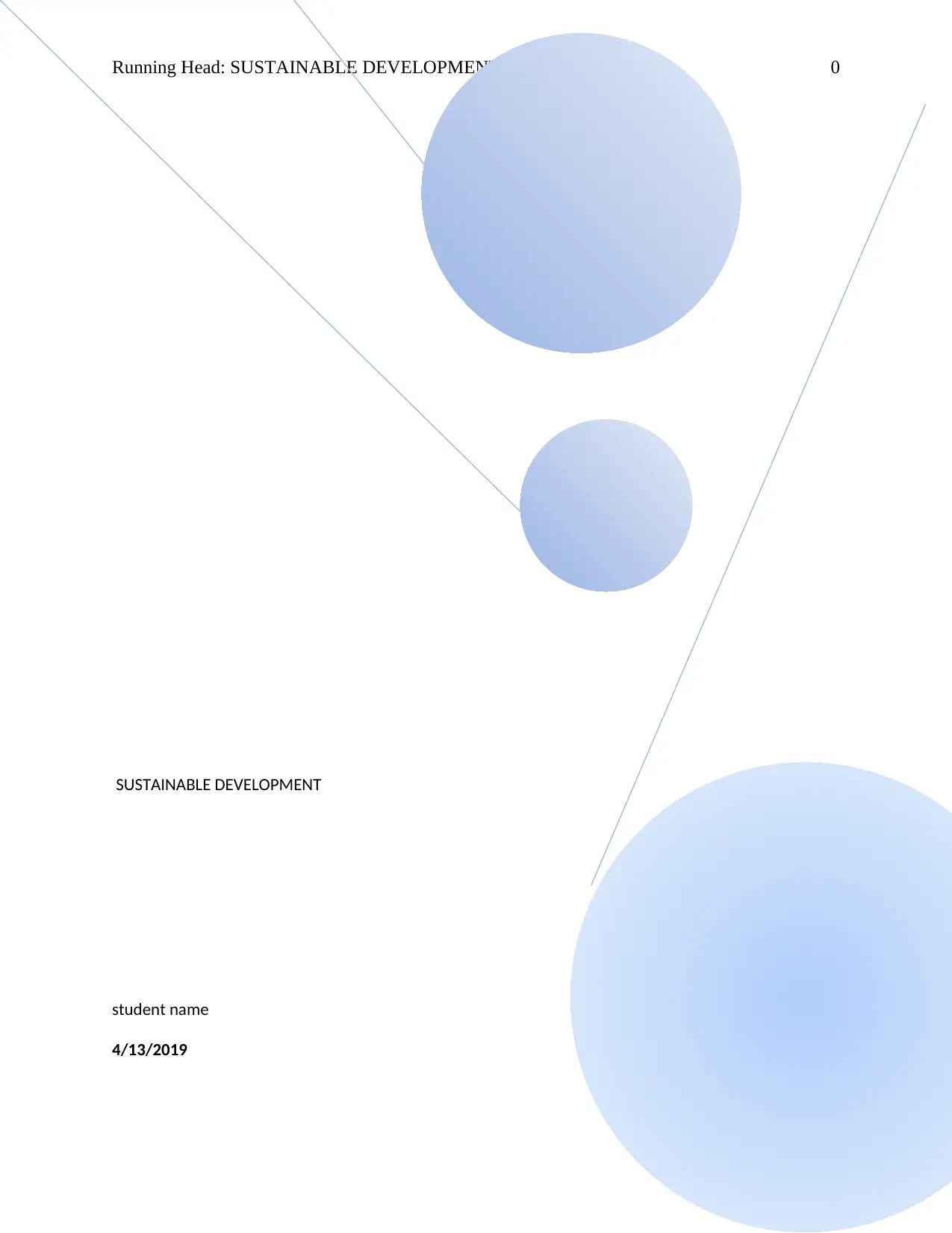
Running Head: SUSTAINABLE DEVELOPMENT 0
SUSTAINABLE DEVELOPMENT
student name
4/13/2019
SUSTAINABLE DEVELOPMENT
student name
4/13/2019
Secure Best Marks with AI Grader
Need help grading? Try our AI Grader for instant feedback on your assignments.

SUSTAINABLE DEVELOPMENT 1
Contents
Sustainable Development................................................................................................................2
Question 1: Triple bottom line.....................................................................................................2
Question 2: Rebound effect.........................................................................................................2
Question 3: Control versus adaption............................................................................................2
Question 4: Ecological footprints................................................................................................3
Question 5: Child labor................................................................................................................3
Question 6: Debt Trap.................................................................................................................4
Question 7: Subsidies..................................................................................................................4
Question 8: Suicidal roles of a person.........................................................................................4
Question 9: Inconvenience sequel...............................................................................................5
Question 10: Organizational focus on the social and environmental consequences of business
activities.......................................................................................................................................5
References........................................................................................................................................6
Contents
Sustainable Development................................................................................................................2
Question 1: Triple bottom line.....................................................................................................2
Question 2: Rebound effect.........................................................................................................2
Question 3: Control versus adaption............................................................................................2
Question 4: Ecological footprints................................................................................................3
Question 5: Child labor................................................................................................................3
Question 6: Debt Trap.................................................................................................................4
Question 7: Subsidies..................................................................................................................4
Question 8: Suicidal roles of a person.........................................................................................4
Question 9: Inconvenience sequel...............................................................................................5
Question 10: Organizational focus on the social and environmental consequences of business
activities.......................................................................................................................................5
References........................................................................................................................................6
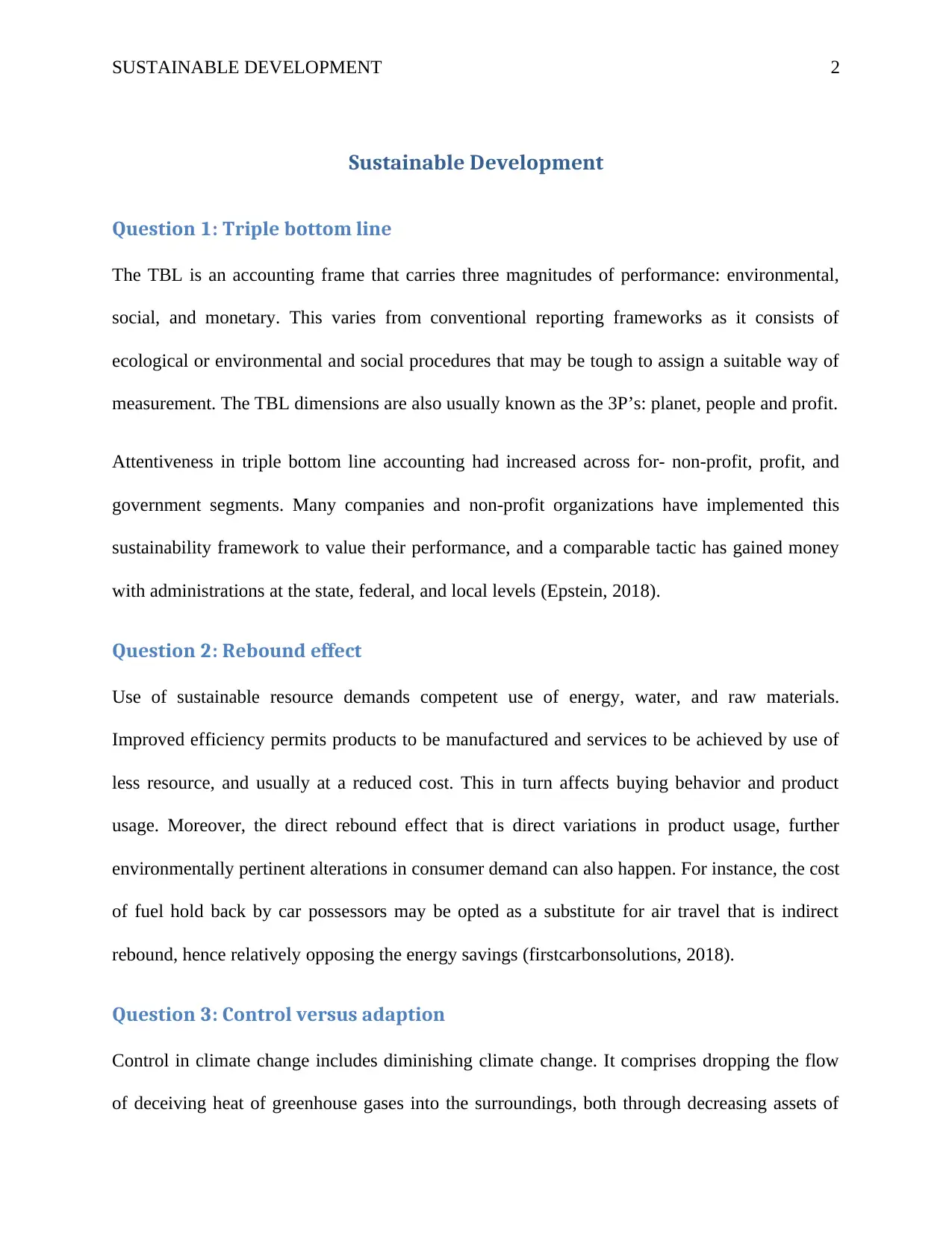
SUSTAINABLE DEVELOPMENT 2
Sustainable Development
Question 1: Triple bottom line
The TBL is an accounting frame that carries three magnitudes of performance: environmental,
social, and monetary. This varies from conventional reporting frameworks as it consists of
ecological or environmental and social procedures that may be tough to assign a suitable way of
measurement. The TBL dimensions are also usually known as the 3P’s: planet, people and profit.
Attentiveness in triple bottom line accounting had increased across for- non-profit, profit, and
government segments. Many companies and non-profit organizations have implemented this
sustainability framework to value their performance, and a comparable tactic has gained money
with administrations at the state, federal, and local levels (Epstein, 2018).
Question 2: Rebound effect
Use of sustainable resource demands competent use of energy, water, and raw materials.
Improved efficiency permits products to be manufactured and services to be achieved by use of
less resource, and usually at a reduced cost. This in turn affects buying behavior and product
usage. Moreover, the direct rebound effect that is direct variations in product usage, further
environmentally pertinent alterations in consumer demand can also happen. For instance, the cost
of fuel hold back by car possessors may be opted as a substitute for air travel that is indirect
rebound, hence relatively opposing the energy savings (firstcarbonsolutions, 2018).
Question 3: Control versus adaption
Control in climate change includes diminishing climate change. It comprises dropping the flow
of deceiving heat of greenhouse gases into the surroundings, both through decreasing assets of
Sustainable Development
Question 1: Triple bottom line
The TBL is an accounting frame that carries three magnitudes of performance: environmental,
social, and monetary. This varies from conventional reporting frameworks as it consists of
ecological or environmental and social procedures that may be tough to assign a suitable way of
measurement. The TBL dimensions are also usually known as the 3P’s: planet, people and profit.
Attentiveness in triple bottom line accounting had increased across for- non-profit, profit, and
government segments. Many companies and non-profit organizations have implemented this
sustainability framework to value their performance, and a comparable tactic has gained money
with administrations at the state, federal, and local levels (Epstein, 2018).
Question 2: Rebound effect
Use of sustainable resource demands competent use of energy, water, and raw materials.
Improved efficiency permits products to be manufactured and services to be achieved by use of
less resource, and usually at a reduced cost. This in turn affects buying behavior and product
usage. Moreover, the direct rebound effect that is direct variations in product usage, further
environmentally pertinent alterations in consumer demand can also happen. For instance, the cost
of fuel hold back by car possessors may be opted as a substitute for air travel that is indirect
rebound, hence relatively opposing the energy savings (firstcarbonsolutions, 2018).
Question 3: Control versus adaption
Control in climate change includes diminishing climate change. It comprises dropping the flow
of deceiving heat of greenhouse gases into the surroundings, both through decreasing assets of
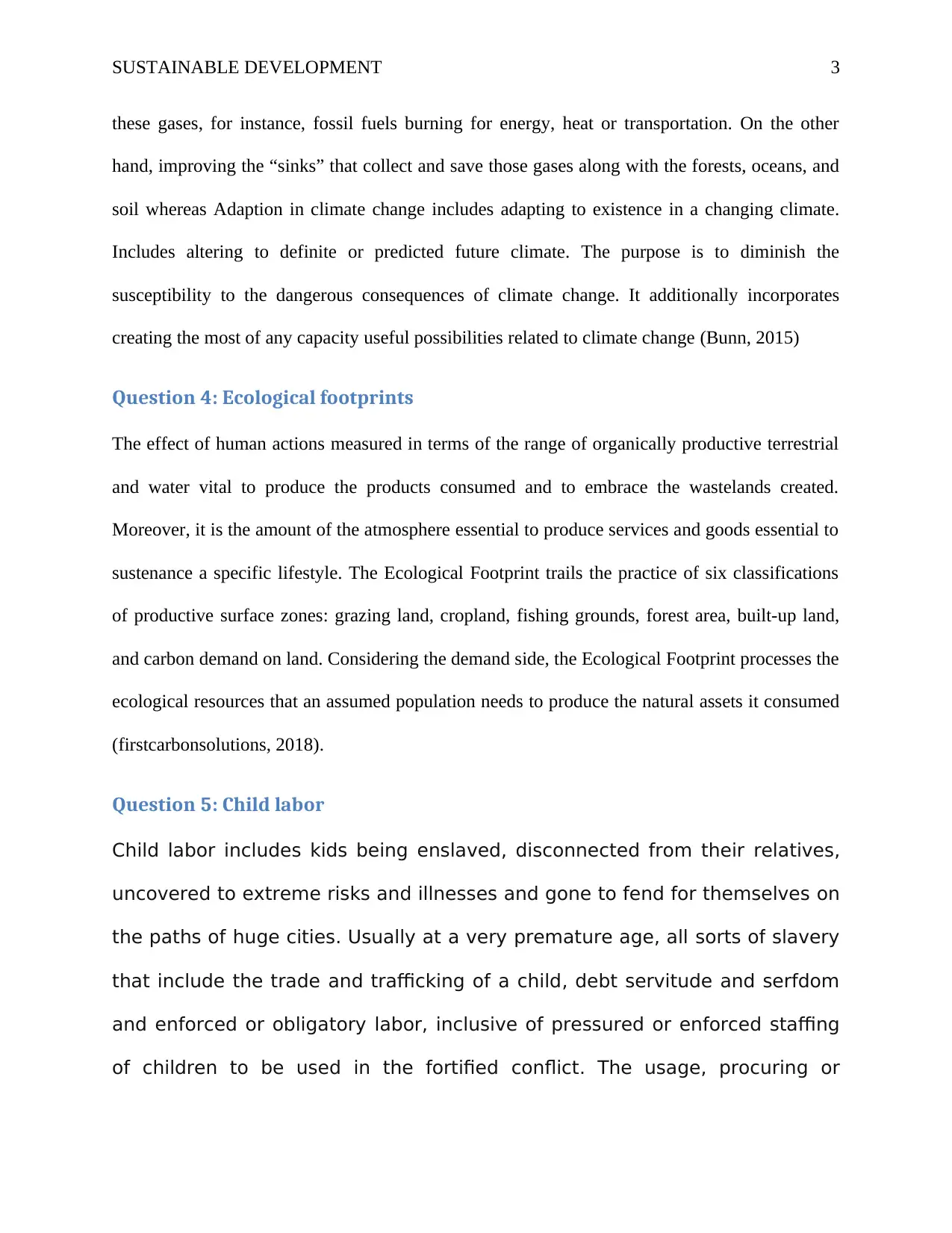
SUSTAINABLE DEVELOPMENT 3
these gases, for instance, fossil fuels burning for energy, heat or transportation. On the other
hand, improving the “sinks” that collect and save those gases along with the forests, oceans, and
soil whereas Adaption in climate change includes adapting to existence in a changing climate.
Includes altering to definite or predicted future climate. The purpose is to diminish the
susceptibility to the dangerous consequences of climate change. It additionally incorporates
creating the most of any capacity useful possibilities related to climate change (Bunn, 2015)
Question 4: Ecological footprints
The effect of human actions measured in terms of the range of organically productive terrestrial
and water vital to produce the products consumed and to embrace the wastelands created.
Moreover, it is the amount of the atmosphere essential to produce services and goods essential to
sustenance a specific lifestyle. The Ecological Footprint trails the practice of six classifications
of productive surface zones: grazing land, cropland, fishing grounds, forest area, built-up land,
and carbon demand on land. Considering the demand side, the Ecological Footprint processes the
ecological resources that an assumed population needs to produce the natural assets it consumed
(firstcarbonsolutions, 2018).
Question 5: Child labor
Child labor includes kids being enslaved, disconnected from their relatives,
uncovered to extreme risks and illnesses and gone to fend for themselves on
the paths of huge cities. Usually at a very premature age, all sorts of slavery
that include the trade and trafficking of a child, debt servitude and serfdom
and enforced or obligatory labor, inclusive of pressured or enforced staffing
of children to be used in the fortified conflict. The usage, procuring or
these gases, for instance, fossil fuels burning for energy, heat or transportation. On the other
hand, improving the “sinks” that collect and save those gases along with the forests, oceans, and
soil whereas Adaption in climate change includes adapting to existence in a changing climate.
Includes altering to definite or predicted future climate. The purpose is to diminish the
susceptibility to the dangerous consequences of climate change. It additionally incorporates
creating the most of any capacity useful possibilities related to climate change (Bunn, 2015)
Question 4: Ecological footprints
The effect of human actions measured in terms of the range of organically productive terrestrial
and water vital to produce the products consumed and to embrace the wastelands created.
Moreover, it is the amount of the atmosphere essential to produce services and goods essential to
sustenance a specific lifestyle. The Ecological Footprint trails the practice of six classifications
of productive surface zones: grazing land, cropland, fishing grounds, forest area, built-up land,
and carbon demand on land. Considering the demand side, the Ecological Footprint processes the
ecological resources that an assumed population needs to produce the natural assets it consumed
(firstcarbonsolutions, 2018).
Question 5: Child labor
Child labor includes kids being enslaved, disconnected from their relatives,
uncovered to extreme risks and illnesses and gone to fend for themselves on
the paths of huge cities. Usually at a very premature age, all sorts of slavery
that include the trade and trafficking of a child, debt servitude and serfdom
and enforced or obligatory labor, inclusive of pressured or enforced staffing
of children to be used in the fortified conflict. The usage, procuring or
Secure Best Marks with AI Grader
Need help grading? Try our AI Grader for instant feedback on your assignments.
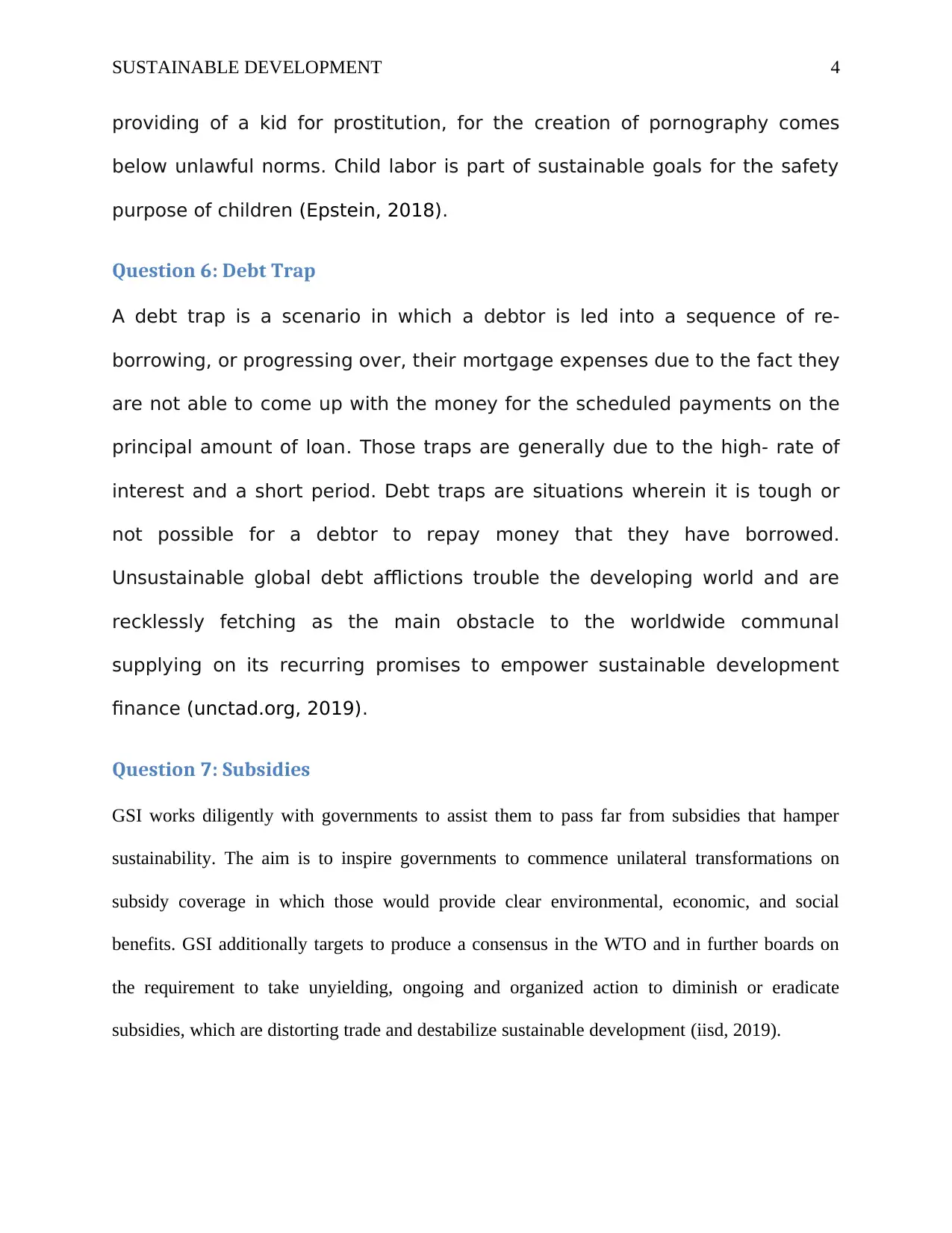
SUSTAINABLE DEVELOPMENT 4
providing of a kid for prostitution, for the creation of pornography comes
below unlawful norms. Child labor is part of sustainable goals for the safety
purpose of children (Epstein, 2018).
Question 6: Debt Trap
A debt trap is a scenario in which a debtor is led into a sequence of re-
borrowing, or progressing over, their mortgage expenses due to the fact they
are not able to come up with the money for the scheduled payments on the
principal amount of loan. Those traps are generally due to the high- rate of
interest and a short period. Debt traps are situations wherein it is tough or
not possible for a debtor to repay money that they have borrowed.
Unsustainable global debt afflictions trouble the developing world and are
recklessly fetching as the main obstacle to the worldwide communal
supplying on its recurring promises to empower sustainable development
finance (unctad.org, 2019).
Question 7: Subsidies
GSI works diligently with governments to assist them to pass far from subsidies that hamper
sustainability. The aim is to inspire governments to commence unilateral transformations on
subsidy coverage in which those would provide clear environmental, economic, and social
benefits. GSI additionally targets to produce a consensus in the WTO and in further boards on
the requirement to take unyielding, ongoing and organized action to diminish or eradicate
subsidies, which are distorting trade and destabilize sustainable development (iisd, 2019).
providing of a kid for prostitution, for the creation of pornography comes
below unlawful norms. Child labor is part of sustainable goals for the safety
purpose of children (Epstein, 2018).
Question 6: Debt Trap
A debt trap is a scenario in which a debtor is led into a sequence of re-
borrowing, or progressing over, their mortgage expenses due to the fact they
are not able to come up with the money for the scheduled payments on the
principal amount of loan. Those traps are generally due to the high- rate of
interest and a short period. Debt traps are situations wherein it is tough or
not possible for a debtor to repay money that they have borrowed.
Unsustainable global debt afflictions trouble the developing world and are
recklessly fetching as the main obstacle to the worldwide communal
supplying on its recurring promises to empower sustainable development
finance (unctad.org, 2019).
Question 7: Subsidies
GSI works diligently with governments to assist them to pass far from subsidies that hamper
sustainability. The aim is to inspire governments to commence unilateral transformations on
subsidy coverage in which those would provide clear environmental, economic, and social
benefits. GSI additionally targets to produce a consensus in the WTO and in further boards on
the requirement to take unyielding, ongoing and organized action to diminish or eradicate
subsidies, which are distorting trade and destabilize sustainable development (iisd, 2019).
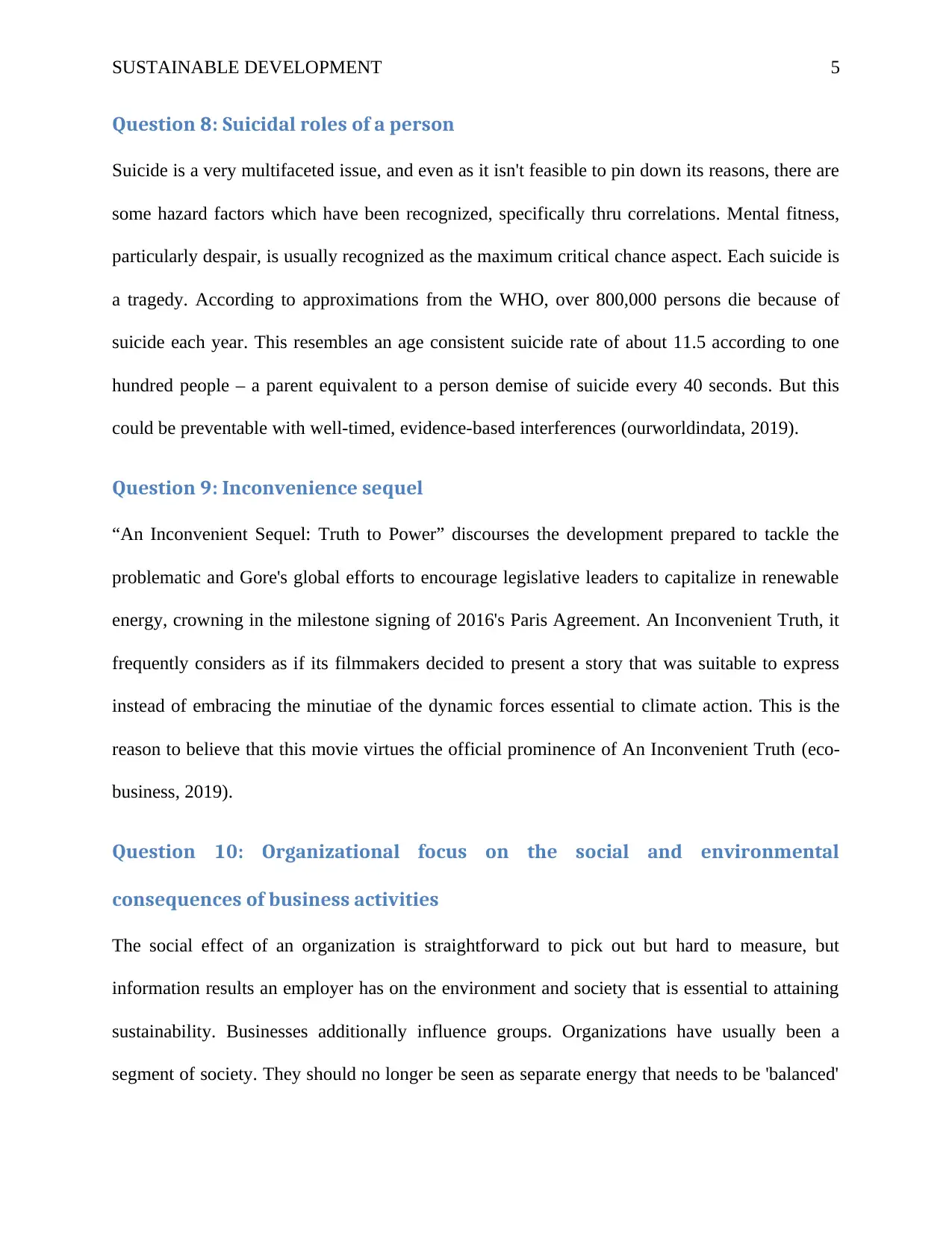
SUSTAINABLE DEVELOPMENT 5
Question 8: Suicidal roles of a person
Suicide is a very multifaceted issue, and even as it isn't feasible to pin down its reasons, there are
some hazard factors which have been recognized, specifically thru correlations. Mental fitness,
particularly despair, is usually recognized as the maximum critical chance aspect. Each suicide is
a tragedy. According to approximations from the WHO, over 800,000 persons die because of
suicide each year. This resembles an age consistent suicide rate of about 11.5 according to one
hundred people – a parent equivalent to a person demise of suicide every 40 seconds. But this
could be preventable with well-timed, evidence-based interferences (ourworldindata, 2019).
Question 9: Inconvenience sequel
“An Inconvenient Sequel: Truth to Power” discourses the development prepared to tackle the
problematic and Gore's global efforts to encourage legislative leaders to capitalize in renewable
energy, crowning in the milestone signing of 2016's Paris Agreement. An Inconvenient Truth, it
frequently considers as if its filmmakers decided to present a story that was suitable to express
instead of embracing the minutiae of the dynamic forces essential to climate action. This is the
reason to believe that this movie virtues the official prominence of An Inconvenient Truth (eco-
business, 2019).
Question 10: Organizational focus on the social and environmental
consequences of business activities
The social effect of an organization is straightforward to pick out but hard to measure, but
information results an employer has on the environment and society that is essential to attaining
sustainability. Businesses additionally influence groups. Organizations have usually been a
segment of society. They should no longer be seen as separate energy that needs to be 'balanced'
Question 8: Suicidal roles of a person
Suicide is a very multifaceted issue, and even as it isn't feasible to pin down its reasons, there are
some hazard factors which have been recognized, specifically thru correlations. Mental fitness,
particularly despair, is usually recognized as the maximum critical chance aspect. Each suicide is
a tragedy. According to approximations from the WHO, over 800,000 persons die because of
suicide each year. This resembles an age consistent suicide rate of about 11.5 according to one
hundred people – a parent equivalent to a person demise of suicide every 40 seconds. But this
could be preventable with well-timed, evidence-based interferences (ourworldindata, 2019).
Question 9: Inconvenience sequel
“An Inconvenient Sequel: Truth to Power” discourses the development prepared to tackle the
problematic and Gore's global efforts to encourage legislative leaders to capitalize in renewable
energy, crowning in the milestone signing of 2016's Paris Agreement. An Inconvenient Truth, it
frequently considers as if its filmmakers decided to present a story that was suitable to express
instead of embracing the minutiae of the dynamic forces essential to climate action. This is the
reason to believe that this movie virtues the official prominence of An Inconvenient Truth (eco-
business, 2019).
Question 10: Organizational focus on the social and environmental
consequences of business activities
The social effect of an organization is straightforward to pick out but hard to measure, but
information results an employer has on the environment and society that is essential to attaining
sustainability. Businesses additionally influence groups. Organizations have usually been a
segment of society. They should no longer be seen as separate energy that needs to be 'balanced'
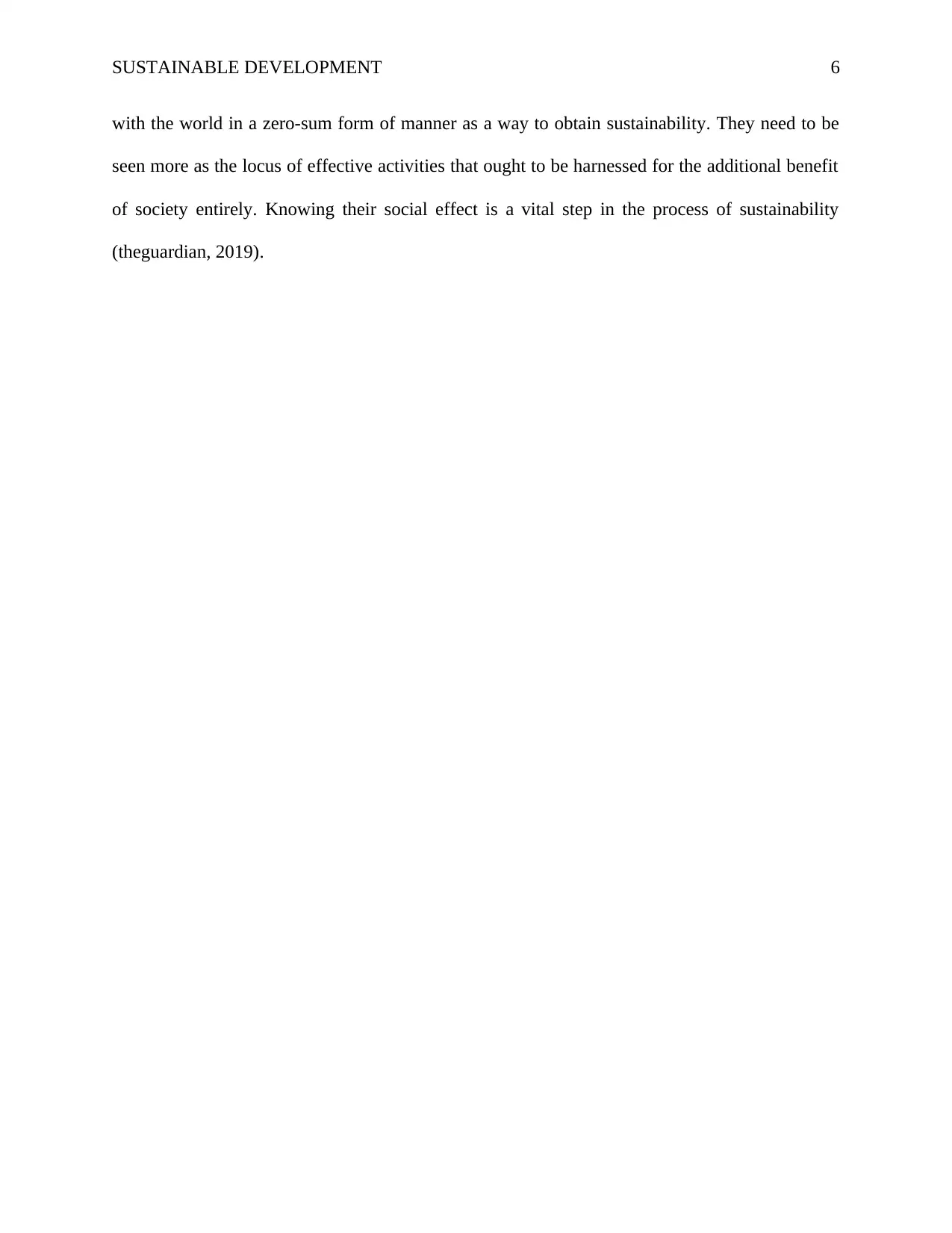
SUSTAINABLE DEVELOPMENT 6
with the world in a zero-sum form of manner as a way to obtain sustainability. They need to be
seen more as the locus of effective activities that ought to be harnessed for the additional benefit
of society entirely. Knowing their social effect is a vital step in the process of sustainability
(theguardian, 2019).
with the world in a zero-sum form of manner as a way to obtain sustainability. They need to be
seen more as the locus of effective activities that ought to be harnessed for the additional benefit
of society entirely. Knowing their social effect is a vital step in the process of sustainability
(theguardian, 2019).
Paraphrase This Document
Need a fresh take? Get an instant paraphrase of this document with our AI Paraphraser
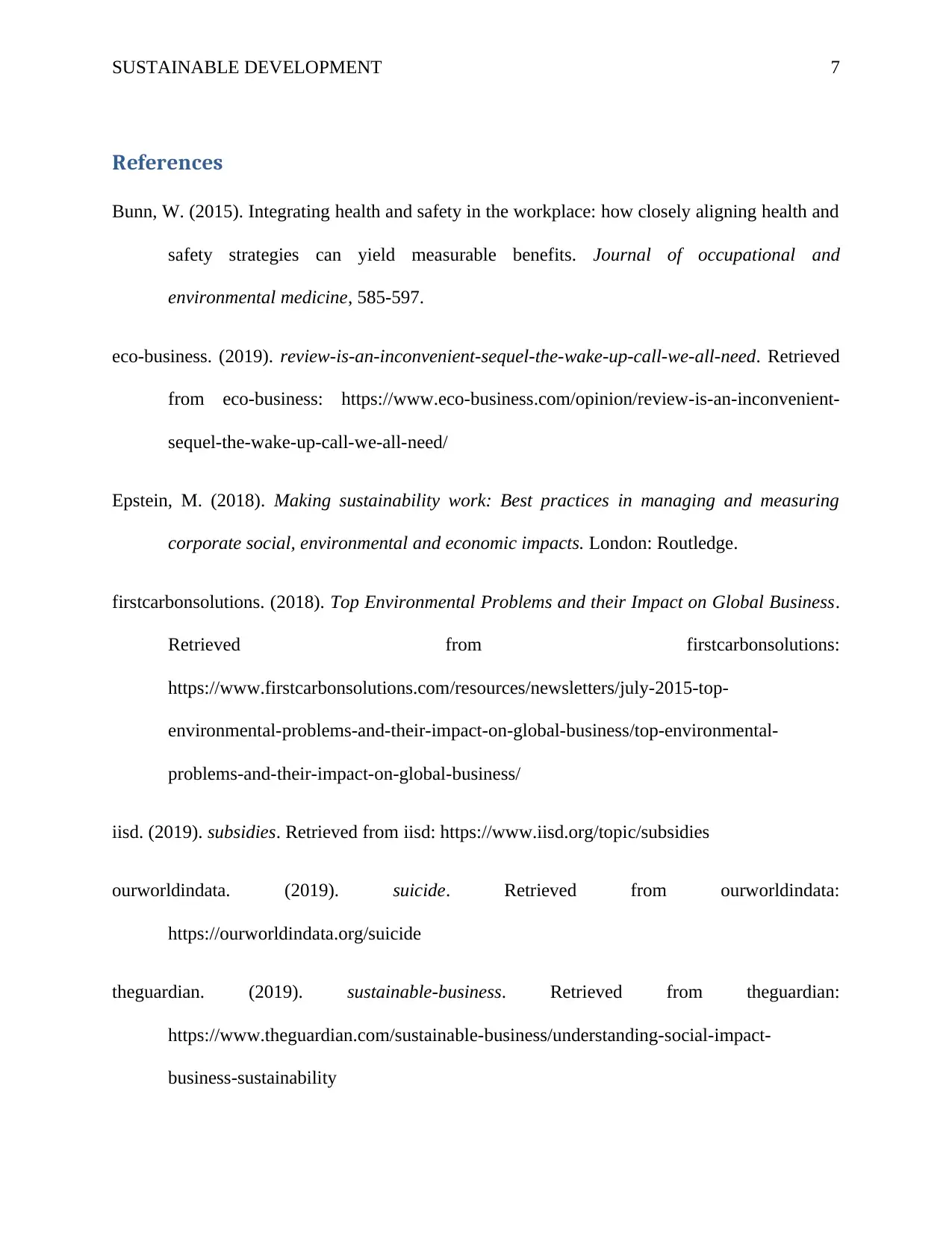
SUSTAINABLE DEVELOPMENT 7
References
Bunn, W. (2015). Integrating health and safety in the workplace: how closely aligning health and
safety strategies can yield measurable benefits. Journal of occupational and
environmental medicine, 585-597.
eco-business. (2019). review-is-an-inconvenient-sequel-the-wake-up-call-we-all-need. Retrieved
from eco-business: https://www.eco-business.com/opinion/review-is-an-inconvenient-
sequel-the-wake-up-call-we-all-need/
Epstein, M. (2018). Making sustainability work: Best practices in managing and measuring
corporate social, environmental and economic impacts. London: Routledge.
firstcarbonsolutions. (2018). Top Environmental Problems and their Impact on Global Business.
Retrieved from firstcarbonsolutions:
https://www.firstcarbonsolutions.com/resources/newsletters/july-2015-top-
environmental-problems-and-their-impact-on-global-business/top-environmental-
problems-and-their-impact-on-global-business/
iisd. (2019). subsidies. Retrieved from iisd: https://www.iisd.org/topic/subsidies
ourworldindata. (2019). suicide. Retrieved from ourworldindata:
https://ourworldindata.org/suicide
theguardian. (2019). sustainable-business. Retrieved from theguardian:
https://www.theguardian.com/sustainable-business/understanding-social-impact-
business-sustainability
References
Bunn, W. (2015). Integrating health and safety in the workplace: how closely aligning health and
safety strategies can yield measurable benefits. Journal of occupational and
environmental medicine, 585-597.
eco-business. (2019). review-is-an-inconvenient-sequel-the-wake-up-call-we-all-need. Retrieved
from eco-business: https://www.eco-business.com/opinion/review-is-an-inconvenient-
sequel-the-wake-up-call-we-all-need/
Epstein, M. (2018). Making sustainability work: Best practices in managing and measuring
corporate social, environmental and economic impacts. London: Routledge.
firstcarbonsolutions. (2018). Top Environmental Problems and their Impact on Global Business.
Retrieved from firstcarbonsolutions:
https://www.firstcarbonsolutions.com/resources/newsletters/july-2015-top-
environmental-problems-and-their-impact-on-global-business/top-environmental-
problems-and-their-impact-on-global-business/
iisd. (2019). subsidies. Retrieved from iisd: https://www.iisd.org/topic/subsidies
ourworldindata. (2019). suicide. Retrieved from ourworldindata:
https://ourworldindata.org/suicide
theguardian. (2019). sustainable-business. Retrieved from theguardian:
https://www.theguardian.com/sustainable-business/understanding-social-impact-
business-sustainability
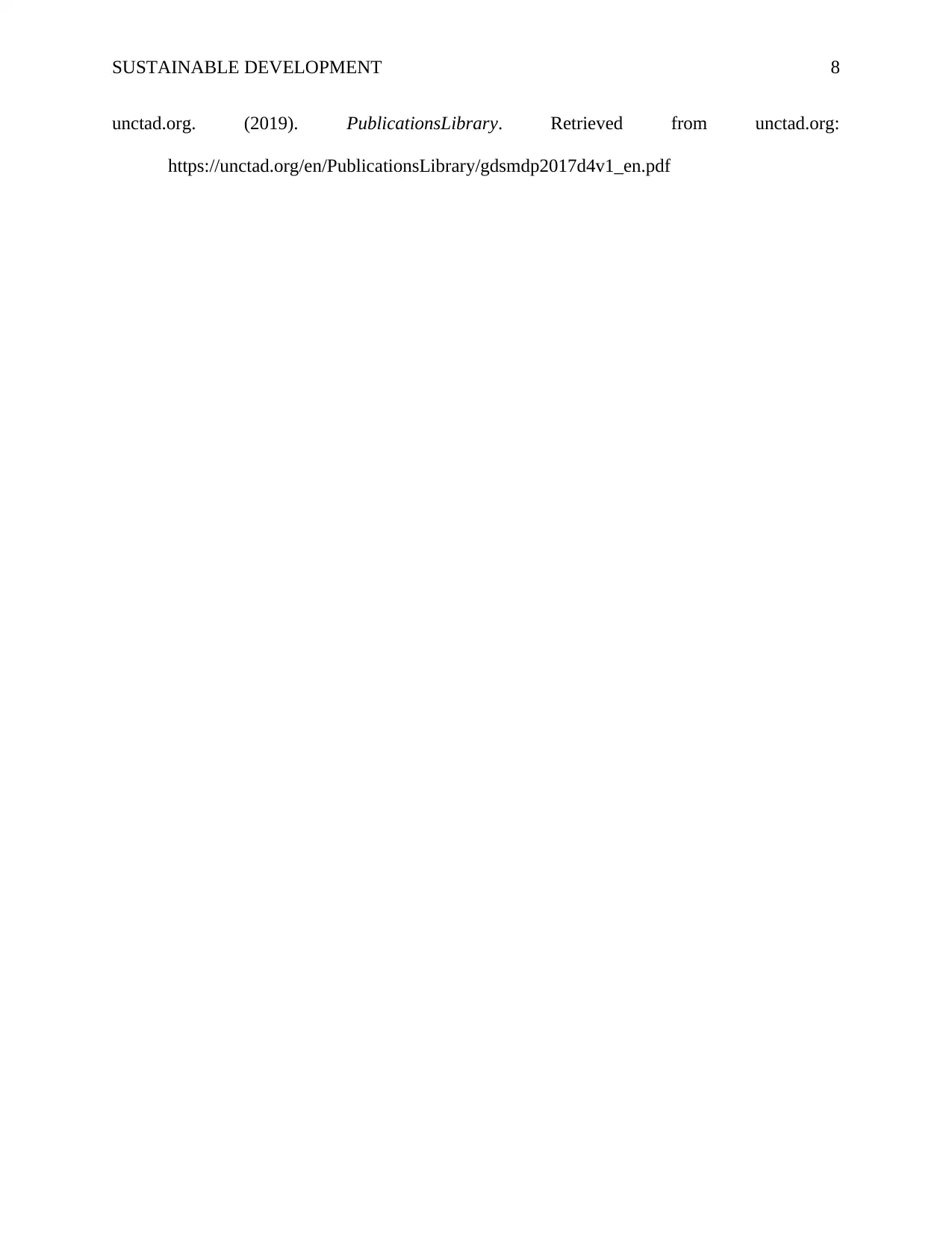
SUSTAINABLE DEVELOPMENT 8
unctad.org. (2019). PublicationsLibrary. Retrieved from unctad.org:
https://unctad.org/en/PublicationsLibrary/gdsmdp2017d4v1_en.pdf
unctad.org. (2019). PublicationsLibrary. Retrieved from unctad.org:
https://unctad.org/en/PublicationsLibrary/gdsmdp2017d4v1_en.pdf
1 out of 9
Related Documents
Your All-in-One AI-Powered Toolkit for Academic Success.
+13062052269
info@desklib.com
Available 24*7 on WhatsApp / Email
![[object Object]](/_next/static/media/star-bottom.7253800d.svg)
Unlock your academic potential
© 2024 | Zucol Services PVT LTD | All rights reserved.





